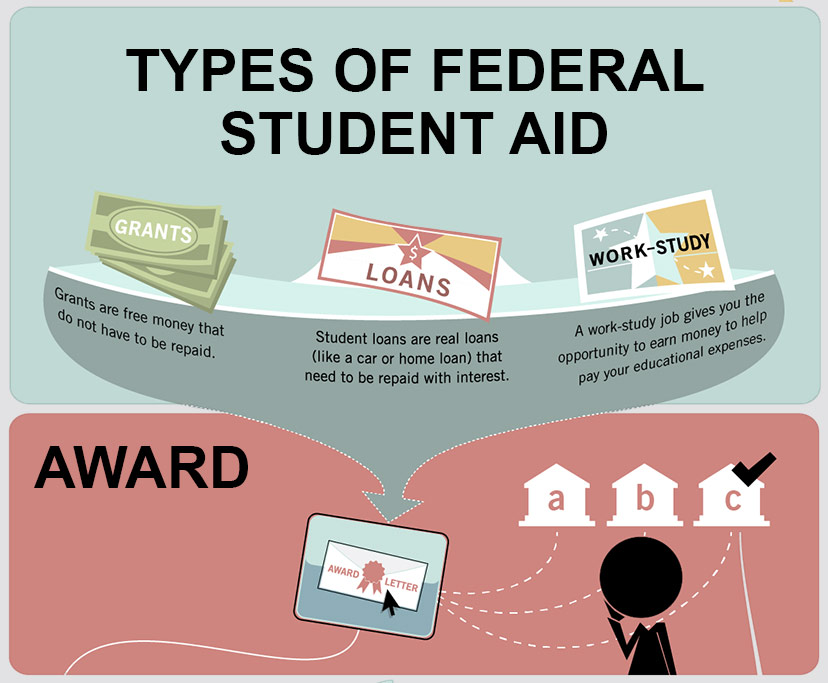The Financial Aid Process
Finding financial aid can seem overwhelming when you’re trying to get ready for college or career school. The US Department of Education’s Office of Federal Student Aid and the California Student Aid Commission are here to help you get the money you need to pay for your education.
Preparation
 Scholarships and state aid can help cover the cost of college or career school, but you may find yourself in need of federal assistance.
Scholarships and state aid can help cover the cost of college or career school, but you may find yourself in need of federal assistance.
Planning:
- To learn about how much it will may cost to attend college, and learn more about financial aid go to: finaid.org or collegeaffordabilityguide.org.
- Starting in your freshman year of high school, follow the High School to College Road Map to make sure you are on the right path.
Savings:
- Start saving early. You will need to pay for some of your education costs.
Scholarships:
- Look for scholarships through your high school’s Counseling Department, your community service organizations and foundations such as Humboldt Area Foundation, as well as national organizations.
- Begin a résumé for scholarship applications; contact people to write letters of recommendation. Keep a record of this. List interests, activities, work experience.
State Aid:
- California has college funding programs. Ask your guidance counselor and go to the California Student Aid Commission’s website above for more information.
- Pay attention to all deadlines, for college applications and scholarships.
Applying for Financial Aid
 See your high school counselor for assistance, or attend a Cash for College event at your high school to help get you started.
See your high school counselor for assistance, or attend a Cash for College event at your high school to help get you started.
FAFSA
- The FAFSA is the Free Application for Federal Student Aid and is the only way to apply for federal student aid. The schools you list on your application will use FAFSA information to evaluate your financial need and determine how much federal aid you are eligible to receive. California uses the FAFSA as its application for state financial aid. Colleges also use the FAFSA to provide their own financial aid. One application, three sources of aid.
- Each October the FAFSA is available for the upcoming school year. It is best to fill it out as early as possible, some aid is first come, first served.
- Complete the application online, and submit each year you are in college.
- You will need to provide personal and tax information – see website for more information.
- After submitting the FAFSA, you will receive your Student Aid Report, (SAR). This report summarizes the information in your FAFSA. Review it and make corrections, if needed. Save a copy.
Dream Act
- Students will complete either the FAFSA or the California Dream Act. Do not complete both. See your high school counselor for more information on CA Dream Act eligibility or use the link above.
- The California Dream Act application determines California state financial aid eligibility for high school students who meet the criteria of California Assembly bill 540 (AB540). It does not provide access to federal student aid. The California Student Aid Commission (see link above) will process applications and any aid received can only be used at eligible California institutions.
- Each October the Dream Act is available for the upcoming school year. It is best to fill it out as early as possible, some aid is first come, first served.
- Complete application online, and submit each year you are in college.
- You will need to provide personal and tax information – see website for more information.
- After submitting the Dream Act, you will receive your Student Aid Report, (SAR). This report summarizes the information in the Dream Act application. Review it and make corrections, if needed. Save a copy.
Types of financial aid
 Your Application helps your college determine the types of financial aid you are eligible to receive.
Your Application helps your college determine the types of financial aid you are eligible to receive.
Grants
- Grants, including scholarships, are free money that do not have to be repaid.
Loans
- Student loans are real loans (like a car or home loan) that need to be repaid with interest. Build a budget to determine if you really need to accept a loan.
Work Study
- A work-study job give you the opportunity to earn money to help pay you educational expenses.
Your Contribution
- Savings from you or your parents will help to cover the costs of your education. Talk with your family about what is affordable.
Awards
You will receive an email from each college you have been accepted into showing you a financial aid award.
- Your award letter explains the combination of grants, loans and work-study a college is offering you.
- If you receive awards from multiple colleges or career schools, you should compare them and decide which school works best for you.
College
Your college or career school has a financial aid office to help guide you along the way.
- Attend college with a plan.
- Use your financial aid wisely; enroll in at least 15 units each term to graduate in four years and make the most of your money.
Beyond Education
Each graduate can help create opportunity for others.
Workforce
- Take the time to plan for your education, get help along the way and you will set a foundation for a bright future and success in the workforce.
- Give back to your community to provide opportunity for other students.
Repayment
- Repay your loans
- Share your story




